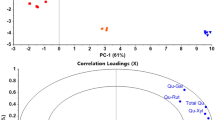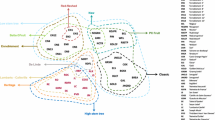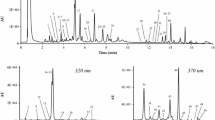Abstract
Phloridzin is a phenolic compound unique to apple (Malus domestica (Suckow) Borkh.) and its wild relatives. Since its discovery, phloridzin has been researched for its nutraceutical properties, including anti-diabetic, anti-cancer, and antioxidant activities, making phloridzin a potential target for nutritional improvement in new apple cultivars. However, phloridzin accumulates at significantly lower concentrations in fruit than in vegetative tissues and seeds. In ‘Golden Delicious’ and its sports, we observed higher phloridzin content in peels of sports with a cuticle disorder termed russet. In russeted apples, the smooth, waxy fruit cuticle is partially or entirely replaced by a corky layer, induced through environmental and genetic effects. To understand the variation of phloridzin content and fruit russet in apple fruit, we surveyed 108 accessions with variation in russeting from the USDA-ARS Malus germplasm collection in Geneva, NY. Russeting in apple fruit ranged from 0 to 100%, and phloridzin content ranged from 24.3 to 825.0 μg/g in peels. Mean phloridzin content varied significantly between russeting groups; in groups with light (0–5%), medium–high (70–80%), and high (90–100%) russeting mean phloridzin content was 115.2, 591.2, and 378.8 μg/g, respectively. We observed that genetic factors and russeting are strong predictors of phloridzin content in peels, but not fruit flesh or leaves. Conversely, other peel phenolics are negatively associated with russeting. We observed variable phloridzin content related to russet incidence during fruit development in ‘Golden Delicious’ (low to medium russet) and its sports, ‘Empress Spur’ (low russet), ‘Razor’ (complete russet), and ‘Sergeant Russet’ (medium to high russet).






Similar content being viewed by others
References
Ampomah-Dwamena C, Dejnoprat S, Lewis D, Sutherland P, Volz RK, Allan AC (2012) Metabolic and gene expression analysis of apple (Malus × domestica) carotenogenesis. J Exp Bot 63:4497–4511. https://doi.org/10.1093/jxb/ers134
Anastasiadi M, Mohareb F, Redfern SP, Berry M, Simmonds MSJ, Terry LA (2017) Biochemical profile of heritage and modern apple cultivars and application of machine learning methods to predict usage, age, and harvest season. J Agric Food Chem. https://doi.org/10.1021/acs.jafc.7b00500
Andre CM, Greenwood JM, Walker EG, Rassam M, Sullivan M, Evers D, Perry NB, Laing WA (2012) Anti-inflammatory procyanidins and triterpenes in 109 apple varieties. J Agric Food Chem 60:10546–10554. https://doi.org/10.1021/jf302809k
Andre CM, Larsen L, Burgess EJ, Jensen DJ, Cooney JM, Evers D, Zhang J, Perry NB, Laing WA (2013) Unusual immuno-modulatory triterpene-caffeates in the skins of russeted varieties of apples and pears. J Agric Food Chem 61:2773–2779. https://doi.org/10.1021/jf305190e
Baldi P, Moser M, Brilli M, Vrhovsek U, Pindo M, Si-Ammour A (2017) Fine-tuning of the flavonoid and monolignol pathways during apple early fruit development. Planta 245:1021–1035. https://doi.org/10.1007/s00425-017-2660-5
Barceló-Vidal C, Bonany J, Martín-Fernández JA, Carbó J (2013) Modelling of weather parameters to predict russet on ‘Golden Delicious’ apple. J Hortic Sci Biotechnol 88:624–630. https://doi.org/10.1080/14620316.2013.11513016
Blanpied GD, Silsby K (1992) Predicting harvest date windows for apples. In: Information bulletin 221. Cornell University, Ithaca, NY
Chagné D, Krieger C, Rassam M et al (2012) QTL and candidate gene mapping for polyphenolic composition in apple fruit. BMC Plant Biol 12:12. https://doi.org/10.1186/1471-2229-12-12
Dare AP, Tomes S, Cooney JM, Greenwood DR, Hellens RP (2013) The role of enoyl reductase genes in phloridzin biosynthesis in apple. Plant Physiol Biochem 72:54–61. https://doi.org/10.1016/j.plaphy.2013.02.017
Dare AP, Yauk Y-K, Tomes S, McGhie TK, Rebstock RS, Cooney JM, Atkinson RG (2017) Silencing a phloretin-specific glycosyltransferase perturbs both general phenylpropanoid biosynthesis and plant development. Plant J Cell Mol Biol 91:237–250. https://doi.org/10.1111/tpj.13559
De Paepe D, Valkenborg D, Noten B, Servaes K, Diels L, Loose MD, Van Droogenbroeck B, Voorspoels S (2015) Variability of the phenolic profiles in the fruits from old, recent and new apple cultivars cultivated in Belgium. Metabolomics 11:739–752. https://doi.org/10.1007/s11306-014-0730-2
Falginella L, Cipriani G, Monte C, Gregori R, Testolin R, Velasco R, Troggio M, Tartarini S (2015) A major QTL controlling apple skin russeting maps on the linkage group 12 of ‘Renetta Grigia di Torriana’. BMC Plant Biol 15:150
Fang T, Zhen Q, Liao L, Owiti A, Zhao L, Korban SS, Han Y (2017) Variation of ascorbic acid concentration in fruits of cultivated and wild apples. Food Chem 225:132–137. https://doi.org/10.1016/j.foodchem.2017.01.014
Gaucher M, Dugé de Bernonville T, Guyot S, Dat JF, Brisset M-N (2013) Same ammo, different weapons: enzymatic extracts from two apple genotypes with contrasted susceptibilities to fire blight (Erwinia amylovora) differentially convert phloridzin and phloretin in vitro. Plant Physiol Biochem 72:178–189. https://doi.org/10.1016/j.plaphy.2013.03.012
Ginzberg I, Stern RA (2016) Strengthening fruit-skin resistance to growth strain by application of plant growth regulators. Sci Hortic 198:150–153
Ginzberg I, Fogelman E, Rosenthal L, Stern RA (2014) Maintenance of high epidermal cell density and reduced calyx-end cracking in developing ‘Pink Lady’ apples treated with a combination of cytokinin 6-benzyladenine and gibberellins A4 + A7. Sci Hortic 165:324–330
Gosch C, Halbwirth H, Kuhn J, Miosic S, Stich K (2009) Biosynthesis of phloridzin in apple (Malus domestica Borkh.). Plant Sci 176:223–231. https://doi.org/10.1016/j.plantsci.2008.10.011
Gosch C, Halbwirth H, Stich K (2010) Phloridzin: biosynthesis, distribution and physiological relevance in plants. Phytochem 71:838–843. https://doi.org/10.1016/j.phytochem.2010.03.003
Gross BL, Volk GM, Richards CM, Forsline PL, Fazio G, Chao CT (2012) Identification of ‘duplicate’ accessions within the USDA-ARS National Plant Germplasm System Malus collection. J Am Soc Hortic Sci 137:333–342
Gutierrez BL, Zhong G-Y, Brown SK (2018) Genetic diversity of dihydrochalcone content in Malus germplasm. Genet Resour Crop Evol 65:1485–1502. https://doi.org/10.1007/s10722-018-0632-7
Hyson DA (2011) A comprehensive review of apples and apple components and their relationship to human health. Adv Nutr Int Rev J 2:408–420. https://doi.org/10.3945/an.111.000513
Khan SA, Chibon P-Y, de Vos RCH et al (2012) Genetic analysis of metabolites in apple fruits indicates an mQTL hotspot for phenolic compounds on linkage group 16. J Exp Bot 63:2895–2908. https://doi.org/10.1093/jxb/err464
Khanal BP, Knoche M, Bussler S, Schlueter O (2014) Evidence for a radial strain gradient in apple fruit cuticles. Planta 240:891–897. https://doi.org/10.1007/s00425-014-2132-0
Knoche M, Lang A (2017) Ongoing growth challenges fruit skin integrity. Crit Rev Plant Sci 36:190–215. https://doi.org/10.1080/07352689.2017.1369333
Knoche M, Khanal BP, Stopar M (2011) Russeting and microcracking of ‘Golden Delicious’ apple fruit concomitantly decline due to gibberellin A4+7 application. J Am Soc Hortic Sci 136:159–164
Lashbrooke J, Aharoni A, Costa F (2015) Genome investigation suggests MdSHN3, an APETALA2-domain transcription factor gene, to be a positive regulator of apple fruit cuticle formation and an inhibitor of russet development. J Exp Bot 66:6579–6589
Lashbrooke J, Cohen H, Levy-Samocha D, Tzfadia O, Panizel I, Zeisler V, Massalha H, Stern A, Trainotti L, Schreiber L, Costa F, Aharoni A (2016) MYB107 and MYB9 homologs regulate suberin deposition in angiosperms. Plant Cell 28:2097–2116
Legay S, Guerriero G, André C, Guignard C, Cocco E, Charton S, Boutry M, Rowland O, Hausman J-F (2016) MdMyb93 is a regulator of suberin deposition in russeted apple fruit skins. N Phytol 212:977–991. https://doi.org/10.1111/nph.14170
Legay S, Cocco E, André CM, Guignard C, Hausman J-F, Guerriero G (2017) Differential lipid composition and gene expression in the semi-russeted ‘Cox Orange Pippin’ apple variety. Front Plant Sci. https://doi.org/10.3389/fpls.2017.01656
Liu RH (2013) Health-promoting components of fruits and vegetables in the diet. Adv Nutr Int Rev J 4:384S–392S. https://doi.org/10.3945/an.112.003517
Luévano-Contreras C, Gómez-Ojeda A, Macías-Cervantes MH, Garay-Sevilla ME (2017) Dietary advanced glycation end products and cardiometabolic risk. Curr Diab Rep 17:63. https://doi.org/10.1007/s11892-017-0891-2
Mikulič Petkovšek M, Usenik V, Štampar F (2003) The role of chlorogenic acid in the resistance of apples to apple scab (Venturia inaequalis (Cooke) G. Wind. Aderh.). Res Rep Biotech Fac Univ Ljubl 81:233–242
Najafian M, Jahromi MZ, Nowroznejhad MJ, Khajeaian P, Kargar MM, Sadeghi M, Arasteh A (2012) Phloridzin reduces blood glucose levels and improves lipids metabolism in streptozotocin-induced diabetic rats. Mol Biol Rep 39:5299–5306
R Core Team (2016) R: A language and environment for statistical computing. R Foundation for Statistical Computing, Vienna, Austria. https://www.R-project.org/
Stanger MC, Steffens CA, Soethe C, Moreira MA, do Amarante CVT (2017) Phenolic content and antioxidant activity during the development of ‘Brookfield’ and ‘Mishima’ apples. J Agric Food Chem 65:3453–3459. https://doi.org/10.1021/acs.jafc.6b04695
USDA (2014) National genetic resources program. Germplasm resources information network (GRIN). USDA, ARS Natl. Germplasm Resources Laboratory, Beltsville, MD. http://www.ars-grin.gov/npgs/index.html. Accessed 5 May 2017
Volz RK, McGhie TK (2011) Genetic variability in apple fruit polyphenol composition in Malus × domestica and Malus sieversii germplasm grown in New Zealand. J Agric Food Chem 59:11509–11521. https://doi.org/10.1021/jf202680h
Wang L, Li J, Gao J, Feng X, Shi Z, Gao F, Xu X, Yang L (2014) Inhibitory effect of chlorogenic acid on fruit russeting in ‘Golden Delicious’ apple. Sci Hortic 178:14–22
Yahyaa M, Ali S, Davidovich-Rikanati R, Ibdah M, Shachtier A, Eyal Y, Lewinsohn E, Ibdah M (2017) Characterization of three chalcone synthase-like genes from apple (Malus × domestica Borkh.). Phytochem 140:125–133. https://doi.org/10.1016/j.phytochem.2017.0
Zhang Y, Li P, Cheng L (2010) Developmental changes of carbohydrates, organic acids, amino acids, and phenolic compounds in ‘Honeycrisp’ apple flesh. Food Chem 123:1013–1018. https://doi.org/10.1016/j.foodchem.2010.05.053
Acknowledgements
This project was funded by the USDA-ARS Plant Genetic Resources Unit, Geneva, NY. BG was supported through the USDA Pathways Program. We thank Jie Arro, Lailiang Cheng, and Michael Gore for their input throughout the project, and the PGRU Clonal group for field and database assistance.
Author information
Authors and Affiliations
Corresponding author
Ethics declarations
Conflict of interest
Authors declare they have no conflict of interest.
Rights and permissions
About this article
Cite this article
Gutierrez, B.L., Zhong, GY. & Brown, S.K. Increased phloridzin content associated with russeting in apple (Malus domestica (Suckow) Borkh.) fruit. Genet Resour Crop Evol 65, 2135–2149 (2018). https://doi.org/10.1007/s10722-018-0679-5
Received:
Accepted:
Published:
Issue Date:
DOI: https://doi.org/10.1007/s10722-018-0679-5




